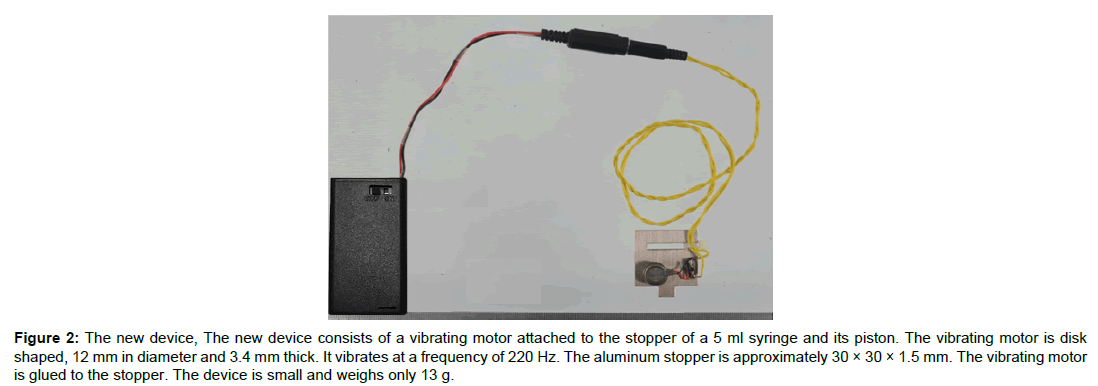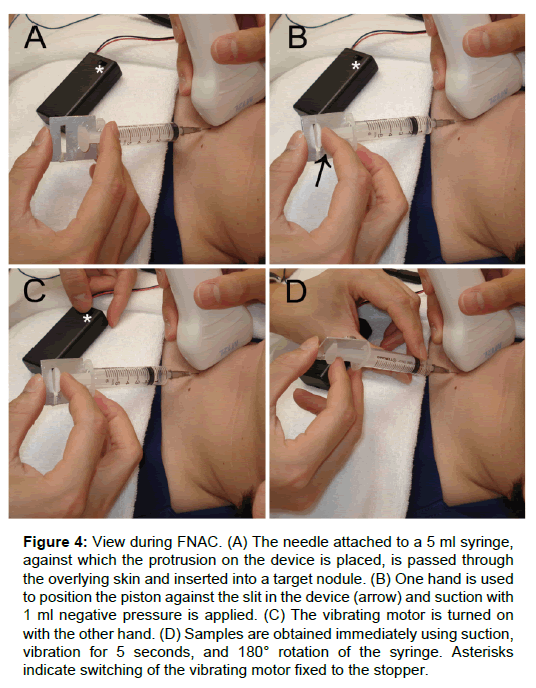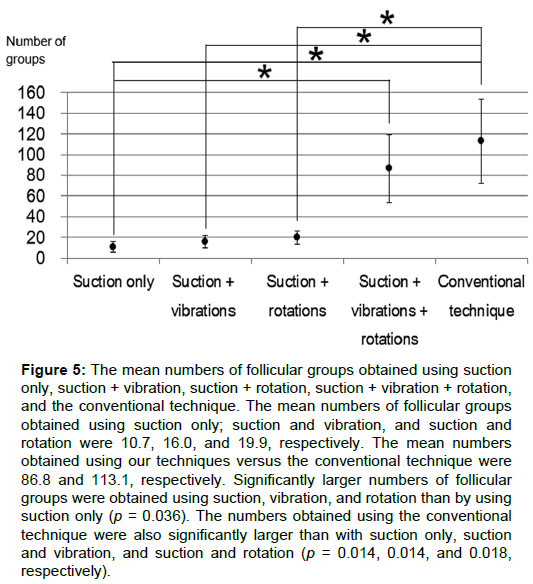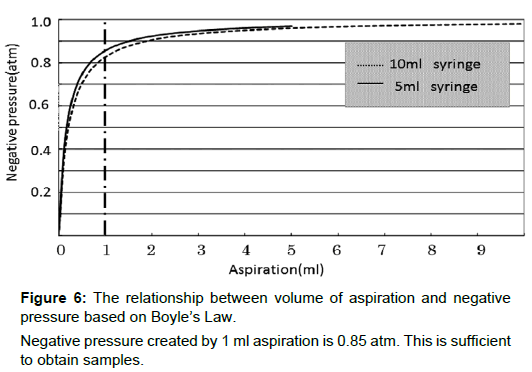Research Article, J Otol Rhinol Vol: 6 Issue: 6
Application of a Novel Vibrating Device for Fine-Needle Aspiration Cytology
Mami Morita1, Ryusuke Hori2*, Shintaro Fujimura2, Yusuke Okanoue2, Tsuyoshi Kojima2, Koichi Omori3 and Kazuhiko Shoji2
1Department of Otolaryngology, National Hospital Organization Kyoto Medical Center, Japan
2Department of Otolaryngology, Tenri Hospital, Japan
3Department of Otolaryngology, Head and Neck Surgery, Kyoto University Graduate School of Medicine, Japan
*Corresponding Author : Ryusuke Hori, MD, PhD
Department of Otolaryngology, Tenri Hospital, 200 Mishima-cho, Tenri, Nara 632-8552, Japan
Tel: +81-743-63-5611
Fax: +81-743-63-1530
E-mail: rhori@tenriyorozu.jp
Received: August 18, 2017 Accepted: September 06, 2017 Published: September 13, 2017
Citation: Morita M, Hori R, Fujimura S, Okanoue Y, Kojima T, et al. (2017) Application of a Novel Vibrating Device for Fine-Needle Aspiration Cytology. J Otol Rhinol 6:6. doi: 10.4172/2324-8785.1000325
Abstract
Objective: Fine-needle aspiration cytology (FNAC) is a valuable diagnostic technique. However, the procedure involves backand-forth motions of a needle within a mass, which can lead to unexpected complications. We have developed a novel device and sampling techniques that use vibration and rotation instead of backand-forth motions.
Methods: The new device consists of a vibrating motor fixed to the stopper of a 5 ml syringe with its piston. A 22-gauge needle attached to the 5 ml syringe is used for FNAC. Samples were obtained from resected specimens using the following four procedures: suction only; suction and vibration for 5 seconds; suction and 180° rotation of the syringe; and suction, vibration for 5 seconds, and 180° rotation of the syringe. Samples were also obtained using the conventional technique. The numbers of well-visualized follicular groups on glass slides were counted to compare the amounts of cellular material obtained using the five different procedures. Next, 415 patients with thyroid nodules underwent ultrasound-guided FNAC to evaluate the rate of inadequacy.
Results: Sufficient amounts of material were obtained from resected specimens using suction, vibration and rotation, and using the conventional technique. Inadequate thyroid FNAC material was obtained in 12.3% of cases.
Conclusions: The new device and sampling techniques for thyroid FNAC collected sufficient amounts of adequate material and allowed safe and precise control of the device. Our device and sampling techniques are expected to be widely used not only for thyroid FNAC sampling but also for sampling from other anatomical sites.
Keywords: Fine-needle aspiration cytology; Vibration; Rotation; Back-and-forth motion; 5 ml syringe; Inadequacy rate; Bethesda system
Introduction
Due to its simplicity and accuracy combined with minimal discomfort and complications, fine-needle aspiration (FNAC) is a valuable diagnostic technique to evaluate suspicious masses in the head and neck region [1]. Recently, ultrasound has become widely used in conjunction with FNAC, as ultrasound guidance improves the ability to obtain a cytologic diagnosis from small lesions as well as those that are inaccessible to FNAC by palpation [2]. FNAC is usually performed using a 21- to 25-gauge needle attached to a 10- or 20 ml syringe, with or without a pistol-type holder (Figure 1). Samples are obtained by back-and-forth cutting motions of the needle within a mass, with vigorous suctioning. Although this technique is relatively straightforward to perform, there are some serious safety concerns to consider. First, these back-and-forth motions within lesions are sometimes associated with unexpected complications [3]. Several important structures and organs are present in the head and neck, including blood vessels, nerves, the trachea, and the thyroid gland. If the tip of the needle accidently contacts these structures, complications may result. Second, a 10- or 20 ml syringe equipped with a holder is so large that it is difficult to control precisely under strong suction in the range of 10–20 ml negative pressure, particularly when acquiring samples from a small mass, so at least two people are needed to obtain samples safely during FNAC. Moreover, some patients are afraid of large syringes and needles, leading to excessive anxiety when the needle penetrates the skin overlying a lesion. Therefore, we developed a novel device that is smaller than the usual 10- or 20 ml syringe with its holder, and a new sampling technique that uses vibration and rotation to obtain samples instead of backand- forth motions. Using this new device and novel techniques, we were able to collect sufficient samples and perform the procedure safely with precise control. In this paper, we introduce the design of our new device and sampling techniques, and describe their utility. To evaluate their efficacy, the amounts of cellular material obtained from surgically removed thyroid specimens were compared among five procedures: four different procedures with our new device and sampling techniques, and the conventional technique of back-andforth cutting motions at the tumor site with vigorous suction using a 20 ml syringe equipped with a pistol-type holder. We also evaluated whether the thyroid FNAC materials obtained using our new device and sampling techniques in a consecutive series of patients were diagnostic or adequate based on the Bethesda system for reporting thyroid cytopathology [4,5].
Materials and Methods
Design of the new device
The new device consists of a vibrating motor attached to the stopper of a 5 ml syringe and its piston. The vibrating motor is disk shaped, 12 mm in diameter, and 3.4 mm thick, and vibrates at a frequency of 220 Hz. The design of the stopper made from aluminum plate is shown in Figure 2. It is approximately 30 × 30 × 1.5 mm, with a protrusion next to the 5 ml syringe and a slit next to the piston. When the stopper is attached to a 5 ml syringe and its piston, negative pressure with 1 ml suction is maintained (Figure 3). As the vibrating motor is glued to the stopper, this device is small and weighs only 13 g. The vibrating motor and aluminum plate are widely available, so anyone can make this device. Optimization of the frequency of vibration was not assessed in this study.
Figure 2: The new device, The new device consists of a vibrating motor attached to the stopper of a 5 ml syringe and its piston. The vibrating motor is disk shaped, 12 mm in diameter and 3.4 mm thick. It vibrates at a frequency of 220 Hz. The aluminum stopper is approximately 30 × 30 × 1.5 mm. The vibrating motor is glued to the stopper. The device is small and weighs only 13 g.
Experimental materials and patients
From 2009 to 2011, a consecutive series of patients underwent thyroid ultrasound and ultrasound-guided FNAC at Tenri Hospital. Six of these patients (four females and two males) who were diagnosed with papillary thyroid carcinoma underwent hemithyroidectomy surgery. Within 1 h after resection, the six resected specimens (which were not preserved in formalin) were used to examine amounts of cellular material obtained by the various methods. To evaluate whether thyroid FNAC samples obtained using our new device and sampling techniques were diagnostic, 415 patients (316 females and 99 males; mean age, 61.5 ± 14.1 years) who had undergone ultrasound-guided FNAC for thyroid nodules ≥ 3 mm in diameter, without thyroid cysts, were enrolled in this study. Specifically, the thyroid nodules were 3-62 mm in size. All patients provided informed consent prior to ultrasound-guided FNAC and hemi-thyroidectomy. We compared the results obtained using our device and sampling techniques with those of 588 patients with thyroid nodules who underwent ultrasound-guided FNAC using the conventional technique in 2007–2009. This study was approved by the institutional review board of Tenri Hospital.
Sampling techniques
A 22-gauge needle attached to a 5 ml syringe was used for FNAC. To perform sampling on the resected specimens, the needle was passed through the capsule of specimens and then inserted into the cancerous sites by palpation. The device, consisting of a stopper glued to a vibrating motor, was attached to the syringe and its piston. Negative pressure was obtained by applying 1 ml suction. Subsequently, samples were obtained using four different procedures: suction only; suction and vibration for 5 seconds; suction and 180° rotation of the syringe; and suction, vibration for 5 seconds, and 180° rotation of the syringe. All suction, vibration, and rotation were halted before the needle was removed. For the conventional technique, samples were obtained by back-and-forth cutting motions in the cancer site with vigorous suction using a 20 ml disposable syringe equipped with a pistol-type holder. These five procedures were performed three times per specimen.
In our study, ultrasound-guided FNAC procedures were performed with patients in a supine position and their neck slightly extended by a pillow placed under their shoulders. The nodule was localized by ultrasound scanning (General Electric LOGIQ 500). Local anesthesia was not applied routinely, but was given (as 0.5% lidocaine) to patients with needle fear and/or excessive anxiety. During FNAC, a needle and attached 5 ml syringe were connected to the protrusion of the new device. The needle then penetrated the overlying skin and was inserted into the target nodule (Figure 4A). One hand was used to position the piston against the slit in the device and then 1 mL negative pressure was applied (Figure 4B). The vibrating motor was then switched on with the other hand (Figure 4C), and samples were obtained by the various techniques using suction, vibration for 5 seconds, and 180° rotation of the syringe (Figure 4D). All suction, vibration, and rotation were halted before the needle was removed. Importantly, no back-andforth motions were used.
Figure 4: View during FNAC. (A) The needle attached to a 5 ml syringe, against which the protrusion on the device is placed, is passed through the overlying skin and inserted into a target nodule. (B) One hand is used to position the piston against the slit in the device (arrow) and suction with 1 ml negative pressure is applied. (C) The vibrating motor is turned on with the other hand. (D) Samples are obtained immediately using suction, vibration for 5 seconds, and 180° rotation of the syringe. Asterisks indicate switching of the vibrating motor fixed to the stopper.
Cytological assessment and criteria for adequacy
After aspiration from the six surgically removed thyroid specimens, samples were suspended in a small amount of physiological saline. The cell suspension was then centrifuged at 1,000 rpm for 3 min (AutoSmear). Next, the cells were fixed on glass slides using AutoSmear with 95% ethanol fixation and stained with Papanicolaou. The numbers of well-preserved and well-stained follicular groups containing at least 10 cells per group were counted to compare the amounts of cellular material obtained using the five different procedures.
FNAC was performed using the new device on 415 patients with thyroid tumors. The aspirated samples were quickly spread on glass slides, air-dried and alcohol-fixed. The smears were then stained using Diff-Quick and Papanicolaou. Diff-Quick samples were reviewed by a cytologist at the bedside. If the first sample was insufficient, or was non-diagnostic due to obscuring blood, additional sampling was immediately performed. A thyroid FNAC sample was considered adequate for evaluation if it contained a minimum of six groups of well-visualized (i.e., well-stained, undistorted, and unobstructed) follicular cells, with at least 10 cells per group, preferably on a single slide. These criteria were based on the Bethesda system for reporting thyroid cytopathology [4].
Statistical Analysis
Bartlett’s test was used to test for equal variance across the groups assessed using the five different procedures. When variance was not equal, the Kruskal–Wallis test was used to determine the overall differences among the five groups. For post hoc comparisons, the Steel–Dwass test was performed to evaluate the differences between each pair within the five groups. The level of statistical significance was set at p<0.05. Values are expressed as means± the standard error of the mean (SEM).
Inadequate samples were compared between the thyroid FNAC materials obtained using our new device and sampling techniques and those obtained using the conventional technique using the Chisquare test.
Results
The mean numbers of follicular groups (containing at least 10 cells per group) obtained with suction only, suction and vibration for 5 seconds, and suction and 180° rotation of the syringe were 10.7, 16.0, and 19.9, respectively. The mean numbers of follicular groups obtained using our techniques and the conventional technique were 86.8 and 113.1, respectively; the difference between the two was not statistically significant (p=0.919). Variance was not equal among the five groups as determined by Bartlett’s test. The overall differences among the five groups were significant (p=0.003). The numbers of follicular groups obtained using suction, vibration for 5 seconds, and 180° rotation of the syringe were significantly larger than with suction only (p=0.036; Figure 5). Significantly larger numbers were also obtained using the conventional technique than with suction only, suction and vibration for 5 seconds, and suction and 180° rotation of the syringe (p=0.014, 0.014, and 0.018, respectively; Figure 5).
Figure 5: The mean numbers of follicular groups obtained using suction only, suction + vibration, suction + rotation, suction + vibration + rotation, and the conventional technique. The mean numbers of follicular groups obtained using suction only; suction and vibration, and suction and rotation were 10.7, 16.0, and 19.9, respectively. The mean numbers obtained using our techniques versus the conventional technique were 86.8 and 113.1, respectively. Significantly larger numbers of follicular groups were obtained using suction, vibration, and rotation than by using suction only (p = 0.036). The numbers obtained using the conventional technique were also significantly larger than with suction only, suction and vibration, and suction and rotation (p = 0.014, 0.014, and 0.018, respectively).
The thyroid FNAC materials obtained using our new device and sampling techniques were considered inadequate in 12.3% of 415 patients and in 16.9% of 130 patients with nodules ≤ 10 mm. There were no samples with extensive obscuring blood that hindered the evaluation of the follicular cells. No serious complications occurred in any of the 415 patients. On the other hand, using the conventional technique, the FNAC materials obtained from 18.2% of 588 patients and 35.2% of 88 patients with nodules ≤ 10 mm were considered inadequate. Significant differences were identified between inadequate samples of 415 patients obtained using our new device and sampling techniques and those of 588 patients obtained using the conventional technique (p<0.001). Significant differences were also identified between inadequate samples of 130 patients with nodules 10 mm obtained using our new device and sampling techniques and those of 88 patients with nodules ≤ 10 mm obtained using the conventional technique (p<0.001).
Discussion
FNAC is a simple, accurate, and cost-effective technique that is the best choice for diagnostic evaluation of head and neck masses. Furthermore, it is usually a safe diagnostic procedure with rare cases of serious complications. The most common complications, such as local pain or discomfort and minor hematomas, occur post-FNAC. However, serious complications following FNAC have been reported, including massive hematomas, carotid hematomas, infections, recurrent laryngeal nerve injury, vasovagal reactions due to severe pain or anxiety, transient dysphagia, esophageal puncture, tracheal puncture, and tumor dissemination. Furthermore, complications may be underreported due to the reluctance of those performing the aspiration to report them [6-8].
One cause of these unexpected complications is likely the backand- forth motion of the sampling needle within tumor masses. Moreover, the 10- or 20 ml syringes that are usually used for FNAC are very large, and it is difficult to control the syringe and its piston precisely under strong suction with 10-20 ml negative pressure. Consequently, this technique can result in penetrating the dorsal sites of nodules and damage to surrounding structures, particularly when samples are acquired from small nodules. Our novel device is considered a safe instrument because vibration and rotation are used instead of back-and-forth motions, ensuring that dorsal sites of nodules are not penetrated. In this study, using our new device to perform FNAC did not lead to any serious complications. The stopper of the syringe and its piston are designed to maintain negative pressure with 1 mL of suction. Based on Boyle’s Law, this creates sufficient vacuum because only a very small volume of dead space is required in the needle. The calculated negative pressure in a 5 ml syringe under 1 mL of suction is 0.85 atm, which is sufficient to obtain samples (Figure 6). Since the stopper fixed to the vibrating motor is attached to a 5 ml syringe and its piston, the instrument is smaller and lighter than a 20 ml syringe equipped with a holder. This allows our novel device to be manipulated more easily even by small hands and provides more control during tissue sampling. In particular, our new device is useful when sampling is performed in confined spaces within the compact anatomy of the head and neck.
An FNAC sample of the thyroid is considered adequate for evaluation if it contains a minimum of six groups of follicular cells, and inadequate samples are reported as non-diagnostic or unsatisfactory [4,5]. To demonstrate the efficacy of our new device and sampling techniques that use vibration and rotation instead of back-and-forth motions, we compared the amounts of cellular material obtained in thyroid specimens using five procedures, and evaluated whether the thyroid FNAC samples were adequate. The samples obtained using all five procedures contained more than six groups of follicular cells. Although the numbers of follicular groups obtained using suction only, suction and vibration, or suction and rotation were smaller, sufficient amounts of material were obtained with suction, vibration for 5 seconds, and 180° rotation of the syringe, as well as using the conventional technique. There were also no significant differences between the numbers of groups obtained using our techniques versus the conventional procedure. The obliqueness of the needle tip may affect the acquisition of follicular groups during these three procedures. Thyroid cells may be detached by the oblique cutting edge of the needle tip and be aspirated into its lumen when the combined sampling techniques of suction, vibration, and rotation are applied; therefore, material may be obtained as sufficiently as with the conventional technique. Furthermore, 12.3% of samples were inadequate using our new device and sampling techniques compared with 18.2% of samples obtained using the conventional technique, and the difference between these two sampling groups was significant. By contrast, previous studies have reported FNAC inadequacy rates for thyroid tumor samples ranging from 13.4% to 33% [9-11]. The results demonstrate the efficacy of our new device and sampling techniques. In this study, we did not optimize suction or vibration time, but 5 secs are sufficiently short that blood is not aspirated and this time did not affect the percentage of adequate samples.
Our novel device is considered a safe instrument that is easy to control precisely. Sufficient amounts of material were obtained using suction, vibration and rotation, as well as using the conventional technique. Therefore, this device and sampling technique are expected to be widely used. Furthermore, use of this technique at other anatomical sites is also anticipated. Future studies should include assessments of the efficacy of this device and these sampling techniques when sampling parotid glands, submandibular glands, lymphatic nodes, and other head and neck lesion sites.
Conclusion
In this study, we introduced a novel device and new sampling techniques for thyroid FNAC. The new procedure uses vibration and rotation instead of back-and-forth motions of the needle to obtain samples. This allows collection of sufficient amounts of diagnostic material and enables safe and precise control of the device. Our new device and sampling techniques are expected to be widely used not only for thyroid FNAC samples but also at other anatomical sites.
References
- Baloch ZW, LiVolsi VA (2004) Fine-needle aspiration of thyroid nodules: past, present, and future. Endocr Pract 10: 234-241.
- Rausch P, Nowels K, Jeffrey RB Jr (2001) Ultrasonographically guided thyroid biopsy: a review with emphasis on technique. J Ultrasound Med 20: 79-85.
- Polyzos SA, Anastasilakis AD (2011) Rare potential complications of thyroid fine needle biopsy. Hippokratia 15: 116-119.
- Syed AZ, Edmund C (2010) The Bethesda System for Reporting Thyroid Cytopathology: Definitions, Criteria and Explanatory Notes. Springer Science & Business Media, USA.
- Cibas ES, Ali SZ; NCI Thyroid FNA State of the Science Conference (2009) The Bethesda System For Reporting Thyroid Cytopathology. Am J Clin Pathol 132: 658-665.
- Polyzos SA, Anastasilakis AD (2009) Clinical complications following thyroid fine-needle biopsy: a systematic review. Clin Endocrinol (Oxf) 71: 157-165.
- Roh JL (2006) Intrathyroid hemorrhage and acute upper airway obstruction after fine needle aspiration of the thyroid gland. Laryngoscope 116: 154-156.
- Karwowski JK, Nowels KW, McDougall IR, Weigel RJ (2000) Needle track seeding of papillary thyroid carcinoma from fine needle aspiration biopsy. A case report. Acta Cytol 46: 591-595.
- Seiberling KA, Dutra JC, Gunn J (2000) Ultrasound-guided fine needle aspiration biopsy of thyroid nodules performed in the office. Laryngoscope 118: 228-231.
- Bazrafshan H, Azarhoush R, Gholamrezanezhad A (2008) Fine needle aspiration of thyroid nodules in a general teaching hospital setting performing moderate number of biopsies: outcome of indeterminate cytologic results. Endo krynol Pol 59: 385-359.
- Wu M, Burstein DE, Yuan S, Nurse LA, Szporn AH, et al. (2006) A comparative study of 200 fine needle aspiration biopsies performed by clinicians and cytopathologists. Laryngoscope 116: 1212-1215.
 Spanish
Spanish  Chinese
Chinese  Russian
Russian  German
German  French
French  Japanese
Japanese  Portuguese
Portuguese  Hindi
Hindi 








